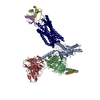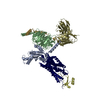+Search query
-Structure paper
| Title | Molecular basis of promiscuous chemokine binding and structural mimicry at the C-X-C chemokine receptor, CXCR2. |
|---|---|
| Journal, issue, pages | Mol Cell, Vol. 85, Issue 5, Page 976-988.e9, Year 2025 |
| Publish date | Mar 6, 2025 |
 Authors Authors | Shirsha Saha / Fumiya K Sano / Saloni Sharma / Manisankar Ganguly / Sudha Mishra / Annu Dalal / Hiroaki Akasaka / Takaaki A Kobayashi / Nashrah Zaidi / Divyanshu Tiwari / Nabarun Roy / Manish K Yadav / Nilanjana Banerjee / Sayantan Saha / Samanwita Mohapatra / Yuzuru Itoh / Andy Chevigné / Ramanuj Banerjee / Wataru Shihoya / Osamu Nureki / Arun K Shukla /   |
| PubMed Abstract | Selectivity of natural agonists for their cognate receptors is a hallmark of G-protein-coupled receptors (GPCRs); however, this selectivity often breaks down at the chemokine receptors. Chemokines ...Selectivity of natural agonists for their cognate receptors is a hallmark of G-protein-coupled receptors (GPCRs); however, this selectivity often breaks down at the chemokine receptors. Chemokines often display promiscuous binding to chemokine receptors, but the underlying molecular determinants remain mostly elusive. Here, we perform a comprehensive transducer-coupling analysis, testing all known C-X-C chemokines on every C-X-C type chemokine receptor to generate a global fingerprint of the selectivity and promiscuity encoded within this system. Taking lead from this, we determine cryoelectron microscopy (cryo-EM) structures of the most promiscuous receptor, C-X-C chemokine receptor 2 (CXCR2), in complex with several chemokines. These structural snapshots elucidate the details of ligand-receptor interactions, including structural motifs, which are validated using mutagenesis and functional experiments. We also observe that most chemokines position themselves on CXCR2 as a dimer while CXCL6 exhibits a monomeric binding pose. Taken together, our findings provide the molecular basis of chemokine promiscuity at CXCR2 with potential implications for developing therapeutic molecules. |
 External links External links |  Mol Cell / Mol Cell /  PubMed:39978339 PubMed:39978339 |
| Methods | EM (single particle) |
| Resolution | 2.8 - 3.71 Å |
| Structure data | EMDB-38719, PDB-8xvu: EMDB-38732, PDB-8xwa: EMDB-38734, PDB-8xwf: EMDB-38738, PDB-8xwm: EMDB-38739, PDB-8xwn: EMDB-38742, PDB-8xws: EMDB-38743, PDB-8xwv: EMDB-38744, PDB-8xx3: EMDB-38747, PDB-8xx6: EMDB-38748, PDB-8xx7: EMDB-38749, PDB-8xxh: EMDB-38759, PDB-8xxr: EMDB-38764, PDB-8xxx: |
| Source |
|
 Keywords Keywords | SIGNALING PROTEIN/IMMUNE SYSTEM / GPCR / Arrestin / SIGNALING PROTEIN-IMMUNE SYSTEM complex |
 Movie
Movie Controller
Controller Structure viewers
Structure viewers About Yorodumi Papers
About Yorodumi Papers





























 homo sapiens (human)
homo sapiens (human)
